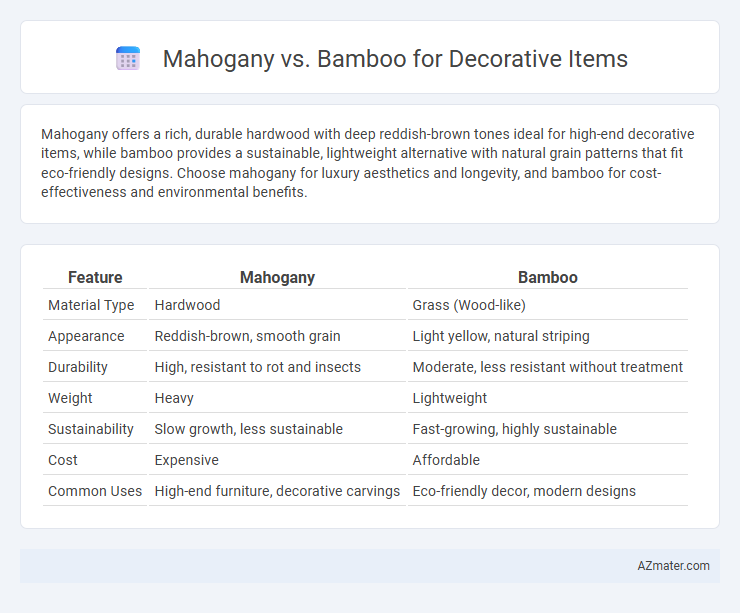Mahogany offers a rich, durable hardwood with deep reddish-brown tones ideal for high-end decorative items, while bamboo provides a sustainable, lightweight alternative with natural grain patterns that fit eco-friendly designs. Choose mahogany for luxury aesthetics and longevity, and bamboo for cost-effectiveness and environmental benefits.
Table of Comparison
| Feature | Mahogany | Bamboo |
|---|---|---|
| Material Type | Hardwood | Grass (Wood-like) |
| Appearance | Reddish-brown, smooth grain | Light yellow, natural striping |
| Durability | High, resistant to rot and insects | Moderate, less resistant without treatment |
| Weight | Heavy | Lightweight |
| Sustainability | Slow growth, less sustainable | Fast-growing, highly sustainable |
| Cost | Expensive | Affordable |
| Common Uses | High-end furniture, decorative carvings | Eco-friendly decor, modern designs |
Introduction to Mahogany and Bamboo
Mahogany, a dense hardwood known for its rich reddish-brown color and fine grain, offers exceptional durability and a luxurious aesthetic for decorative items. Bamboo, a fast-growing grass with a light, natural hue and high tensile strength, provides an eco-friendly and sustainable alternative with a unique texture and flexibility. Both materials bring distinct visual and structural qualities, making them popular choices in interior design and decorative craftsmanship.
Physical Characteristics Comparison
Mahogany features a rich reddish-brown color with a fine, straight grain and a dense, durable texture that resists scratches and dents, making it ideal for high-end decorative items. Bamboo exhibits a lighter, golden-yellow hue with a distinctive, natural linear grain and is known for its lightweight, flexible, and highly renewable properties. While mahogany offers greater hardness and traditional elegance, bamboo provides eco-friendly versatility and a modern aesthetic for decorative purposes.
Aesthetic Appeal for Decorative Items
Mahogany offers a rich, deep reddish-brown hue with fine grain patterns that lend a classic and luxurious aesthetic to decorative items, enhancing sophistication and warmth in interior decor. Bamboo features a lighter, natural color with smooth, consistent texture and subtle nodes, imparting a modern, eco-friendly appeal that complements minimalist and contemporary styles. The choice between mahogany and bamboo for decorative items depends on the desired ambiance, with mahogany favoring traditional elegance and bamboo promoting sustainable, clean-lined designs.
Durability and Longevity
Mahogany offers exceptional durability with its dense grain and natural resistance to decay, making it ideal for decorative items meant to last decades. Bamboo, while less dense, provides impressive longevity due to its rapid growth cycle and natural flexibility, which prevents cracking and warping. Both materials balance strength and aesthetics, but mahogany's superior hardness often ensures longer-lasting decorative appeal in high-traffic or outdoor settings.
Sustainability and Environmental Impact
Mahogany, a slow-growing hardwood, is often sourced from endangered forests, leading to concerns about deforestation and habitat loss, whereas bamboo is a rapidly renewable grass that regenerates quickly without replanting, making it a highly sustainable choice for decorative items. Bamboo's lower environmental footprint includes less water usage and no need for harmful pesticides, contrasting with mahogany's resource-intensive cultivation and harvesting. Choosing bamboo for decorative items supports eco-friendly practices and helps reduce the carbon footprint associated with furniture and decor production.
Cost and Availability
Mahogany, known for its rich color and durability, tends to be more expensive and less readily available due to slower growth rates and limited sustainable harvesting. Bamboo offers a cost-effective alternative with rapid renewability and widespread availability, making it an eco-friendly choice for decorative items. The price difference reflects the scarcity and processing complexity of mahogany compared to the abundance and ease of sourcing bamboo.
Maintenance Requirements
Mahogany requires regular polishing and protection from moisture to maintain its rich, dark finish and prevent warping, making it less ideal for high-humidity environments. Bamboo is highly durable, resistant to moisture, and typically needs only occasional dusting and wiping, offering a low-maintenance option for decorative items. Both materials benefit from avoiding prolonged sun exposure to preserve color and structural integrity.
Versatility in Decorative Design
Mahogany offers rich, deep hues and a fine grain that enhances traditional and classic decorative designs, while bamboo provides a lighter, natural texture perfect for modern, eco-friendly aesthetics. Bamboo's flexibility allows for intricate shaping and sustainable sourcing, making it ideal for versatile decorative accents like wall panels and furniture. Both materials complement diverse interior styles, but bamboo's rapid renewability and adaptability give it an edge in contemporary, sustainable decor trends.
Popular Decorative Uses
Mahogany and bamboo are both favored materials for decorative items, with mahogany prized for its rich, deep reddish-brown tones and fine grain, making it ideal for luxury furniture, picture frames, and intricate carvings. Bamboo is popular for eco-friendly decor, offering a light, natural aesthetic suited for vases, lamps, and wall art due to its sustainability and rapid growth. Both materials enhance interior spaces, with mahogany adding a classic, elegant touch and bamboo providing a modern, organic vibe.
Conclusion: Choosing the Right Material
Mahogany offers rich, deep hues and exceptional durability, making it ideal for high-end, long-lasting decorative items that showcase fine craftsmanship. Bamboo stands out for its eco-friendliness, fast renewability, and lightweight strength, perfect for modern, sustainable designs. Consider the desired aesthetic, environmental impact, and budget to select between mahogany's classic elegance and bamboo's versatile, green appeal.

Infographic: Mahogany vs Bamboo for Decorative Item
 azmater.com
azmater.com